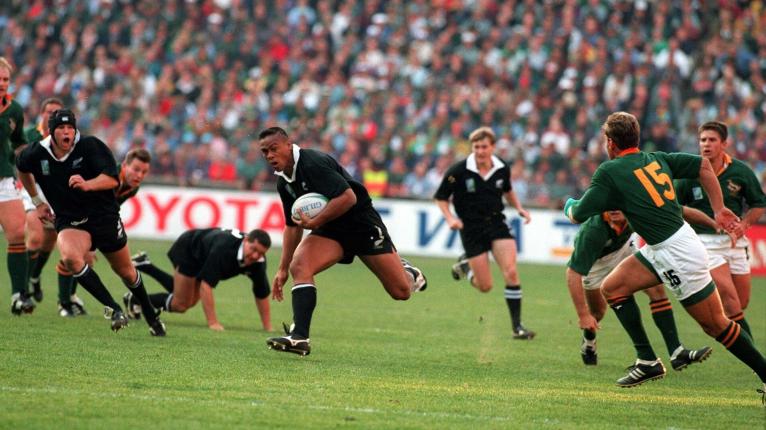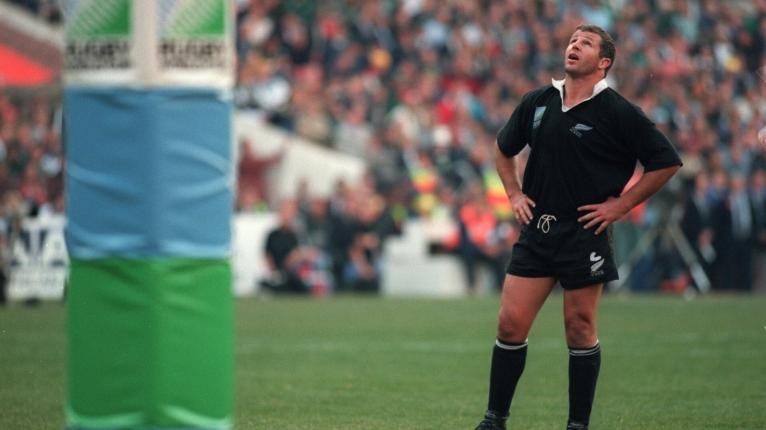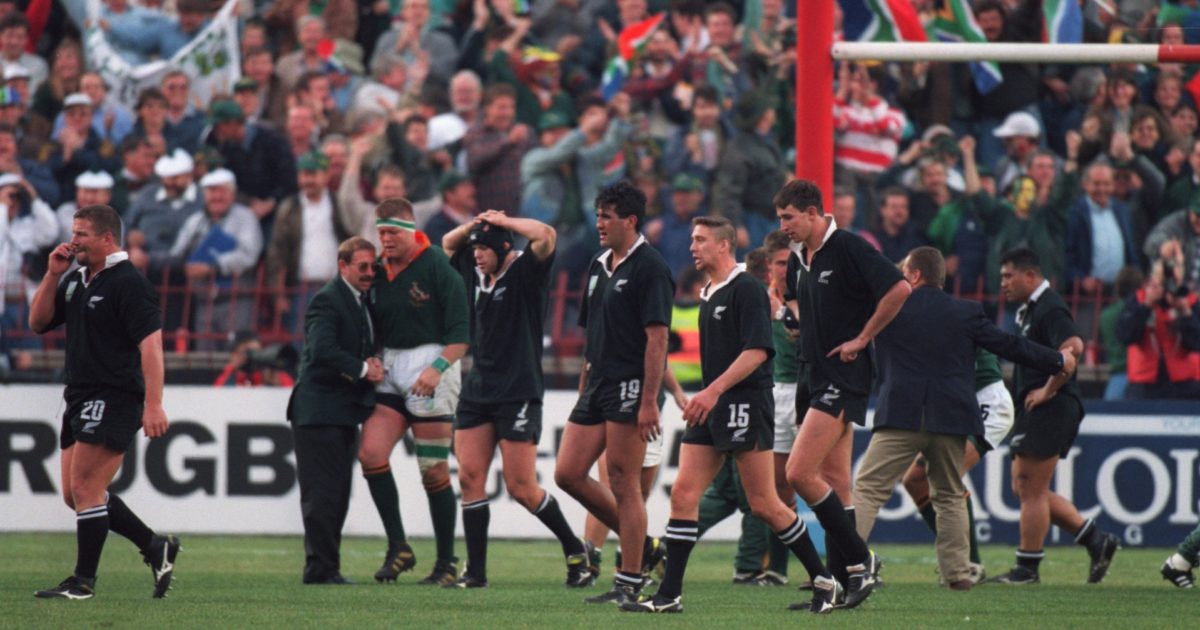Where are they now? The All Blacks team 25 years after their 1995 World Cup final defeat

The All Blacks didn’t apologetically tip-toe their way to the World Cup final in Johannesburg in 1995, they stampeded and bulldozed their way to their date with destiny in a display of shock and awe. They scored 315 points in five matches (averaging 63 points a match) and unearthed the greatest attacking talent in world rugby in Jonah Lomu.
Indeed, the Springboks felling the All Blacks wasn’t quite a David vs Goliath moment, given South Africa were at home, but the fact they were able to stop New Zealander scoring a try in the decider was a credit to their collective defensive resolve.
The conspiracy theorists will always throw up, if you excuse the pun, the fact that a chunk (sorry, again) of the All Blacks squad went down with a stomach bug on the eve of the final, but there was admiration for the way Francois Pienaar’s men clung on to thunderous Kiwi thighs throughout the fixture.
The game itself wasn’t a classic. Andrew Mehrtens fluffed the kick-off in a sign of things to come as the All Blacks lost their rhythm. The Springboks didn’t give them time and disrupted their play, gaining parity in the scrum and felling Jonah Lomu at any opportunity.
At times New Zealand looked jittery and made uncharacteristic errors, but Mehrtens kept in touch with Joel Stransky on the scoreboard. At the break, it was a nervy 9-6 after a first Stransky drop-goal of the afternoon and the game was finely poised.
RugbyPass were lucky enough to speak to Joel Stransky, the man who won the World Cup for South Africa in 1995. 🇿🇦
Stransky was known for his incredible kicking composure, managing to block out the pressure that surrounded him.
Watch the full interview now on all our platforms! pic.twitter.com/QoRuXGbTVF
— RugbyPass (@RugbyPass) June 4, 2020
In the second-half, Mehrtens knocked a drop-goal through the uprights to bring it to 9-9, and as the game became increasingly conservative, no more points were added. In extra-time, the Springboks knew they had to win the game because the All Blacks had a better disciplinary record, given neither side has scored a try in normal time.
Mehrtens struck the first blow with a penalty from distance. When Stransky returned the favour after the All Blacks were penalised, the scores were level again at 12-12 and the final ten minutes of extra-time was about to get underway.
With eight minutes left on the clock, Joost van der Westhuizen whipped the ball back for Stransky to sweep the ball between the uprights and send the Springbok fans into delirium. The All Blacks were unable to trouble the Springbok defence as their game fell apart and while South Africa partied, Sean Fitzpatrick’s men were left to ponder what might have been.
The All Blacks went on to play a pair of Bledisloe Cup matches versus Australia the following month and within weeks the game had officially turned professional. What became of this Class of 1995? RugbyPass takes a step back in time…
15. Glen Osborne
A beautifully balanced runner from deep, where he had the ability to step off both feet and not lose pace, Osborne’s star flickered for the All Blacks at two World Cups. In his modest 19 appearances, he scored a highly creditable eleven tries, playing at full-back and on the wing.
Growing up in Wanganui on the North Island and progressing to North Harbour and the Chiefs, Osborne’s final appearance for New Zealand came at the 1999 World Cup where he crossed for a try-brace against Italy. Post-rugby, he forged a successful career in the media, working as a presenter on Maori Television until he graduated as a constable in the New Zealand police. His current beat is in the Wellington area.
14. Jeff Wilson
A naturally gifted sportsman, who excelled at basketball and track and field, ‘Goldie’ was also a fine cricketer and played in four one-day internationals for the Black Caps before choosing rugby. It proved a wise decision. In 60 Tests for the All Blacks he scored a remarkable 44 tries in an eight-year career on the right flank – and he also chipped in with a conversion, a couple of penalties and a drop-goal in a 234-point haul.
At domestic level he played for Otago and the Highlanders in the Super 12. After hanging up his rugby boots he again played another one-day international for the Black Caps in 2005 before retiring to the family farm in Canterbury.
Rugby lured him back with coaching roles at the Blues and North Harbour before he started a media career in 2013 with Sky Sport NZ, commentating on rugby and cricket (he now hosts The Breakdown, the weekly rugby show). Married to Adine, a former captain of the New Zealand netball team.
⁉️ Did you know today, 14th May 2020, marks exactly 1️⃣5️⃣0️⃣ years since the first ever competitive rugby match in New Zealand? WATCH: Bernadine Oliver-Kerby and the Breakdown team take us for a stroll down memory lane 🏉 pic.twitter.com/c4mauQq1Yu
— Sky Sport NZ (@skysportnz) May 14, 2020
13. Frank Bunce
When you were hit by ‘Eneri’, you stayed hit. One of the hardest tackling centres in world rugby, he was renowned for his physicality but there was guile and craft to his running game as well as he crossed the whitewash on 21 occasions for the All Blacks in his 55 Tests.
Born in Auckland of Samoan heritage, he also turned out for Samoa for four Tests. Sandwiched between the 1991 and 1995 World Cups, Bunce succeeded against the Lions in 1993 series where he formed a highly-effective partnership with Walter Little.
He played his last game for the ABs at 35 before heading to Europe to play with Castres and then Bristol. He stayed on to coach in Italy post-retirement but returned to New Zealand where he had a stint as defence coach for the Blues. Nowadays, he is still coaching position-specific roles for the International Rugby Academy.
12. Walter Little
He played as an understated foil to Bunce’s power throughout the nineties as they vied with Tim Horan and Jason Little for the title of best midfield duo in world rugby. Like Bunce, he was very effective at wrapping up man and ball as he nullified ball-carriers in midfield and played in the 1991 and 1995 World Cup, as well as facing the 1993 Lions.
A serious knee injury to the quiet inside-centre from Tokorua curtailed his 50-cap All Blacks career in 1998 and after a short spell in Japan, he finally hung up his boots. The North Harbour legend moved into the construction industry, working in the Auckland area, and he still keeps his hand in with coaching at grassroots level where he has four sons.
11. Jonah Lomu
He was only 19 when he travelled to South Africa in 1995 but he left it six weeks later as rugby’s first bonafide world superstar. At 6ft 5ins and nearly 19st, he was clocked at 10.8secs in the 100m and this athletic prowess saw him power over for four tries against England in the semi-final, one of the most jaw-dropping performances in the tournament’s history.
Lomu scored 37 tries in 63 Tests and with 15 tries in two World Cups, he retains the joint-record for tries scored in the tournament with Bryan Habana. Despite his fame, Lomu had increasing problems with his health and a kidney issue meant he played his final Test at the age of just 27.
A favourite on the media circuit after finally retiring in 2007, the legend passed away at the age of 40 from ill-health just after the 2015 World Cup.

10. Andrew Mehrtens
Born in Durban, he was brought up in Christchurch from a young age. A Crusaders talisman for a decade he made his bow with the All Blacks in 1993, going on to play for them on 70 occasions and kicking 967 points, a one-time world record.
Pigeon-holed as a kicking 10, in 1995 he showed his attacking élan with a marvellous score against Scotland. He had vision, a varied kicking game and brilliant distribution, but his role was seen as the conductor to one of the most potent backlines in rugby history.
After a stint late in his career with Toulon, Racing 92 and Harlequins, he tried his hand at coaching with a short spell with the Waratahs but has worked in finance the past seven years. Still regularly seen in the commentary box or offering humorous anecdotes in punditry.
9. Graeme Bachop
One of the last of the dive-pass from the base of the scrum contingent, ‘Grim’ represented the All Blacks on 39 occasions. A regular half-back partner of Mehrtens at the Crusaders as well as Test level, he took over from David Kirk as the Kiwi No9 in 1989 and was a mainstay for the 1991 and 1995 World Cup campaigns and the 1993 Lions Test series.
Not especially verbose for a scrum-half, his skills were his whip-smart service and varied running game. Based in Japan before the 1995 World Cup, he was one of the first professional pioneers in the Far East and Laurie Mains’ had to get him a special dispensation to play in South Africa. After eight years in the country, he ended up representing the Brave Blossoms at the 1999 World Cup. Happily retired from the sport, he lives back in Christchurch and works in the building trade.
1. Craig Dowd
A huge man, who stood at 6ft 3ins and weighed in at just under 19st, he formed a formidable front row with Sean Fitzpatrick and Olo Brown throughout the nineties, playing in the 1991 and 1995 World Cups on the way to 60 caps.
Domestically he was highly decorated. After a decade with the Blues, where he won two Super 12 titles in 1996 and 1997, he took the time-honoured route up north where he repeated the trick with Wasps, winning the Heineken Cup in 2004 and the Premiership on three occasions.
After retiring he coached Wasps until 2008 before heading back to New Zealand to take over as head coach at North Harbour. Has since been a commentator for Sky Sport, written columns for ESPN and distributed D3, a strapping tape for multiple sports.
2. Sean Fitzpatrick
‘Fitzy’ was captain of the All Blacks on 51 occasions and started in all but one of his 92 Tests. A victorious skipper of the 1993 Lions zeries, he played in the inaugural 1987 World Cup and led the All Blacks at the 1991 and 1995 tournaments.
He played his best rugby in the second half of his Test career after being stung by a report that said Phil Kearns was the best hooker in the world, and made his final bow in the No2 shirt in 1997 after a decade of service with a knee injury the only opponent that finally floored him.
He also played in a wildly successful Blues side before heading into the world of business and media. Still a regular pundit on Sky Sports in the UK, he is chairman of the Laureus World Sports Academy.

3. Olo Brown
A starter in every one of his 56 Tests, he was entrusted by Mains and John Hart to lock down the All Blacks scrum between 1992 and 1998 where he was widely considered the world’s best tighthead. A chartered accountant by trade, the No3 was born in Apia, Samoa, but played his club rugby in Auckland with Fitzpatrick and latterly Dowd, which helped their familiarity on the Test stage and furnish the trophy cabinet with Super 12 wins.
His Test career came to an abrupt end when injuring his neck and back against South Africa in 1998. Throughout his career he avoided the media and in retirement has preferred to keep a low profile. He is currently working in private equity and lives in the Auckland area.
4. Ian Jones
The ‘Kamo kid’ from Whangarei ruled the skies for nearly a decade in the All Blacks shirt, playing at the 1991, 1995 and 1999 World Cups yet never getting to lift the Webb Ellis Trophy like so many other great All Blacks of the era. He made 79 appearances for New Zealand in a top-class career. A brilliant technician in the lineout, even though he was a gifted athlete, there were worries that his wiry frame wasn’t robust enough for Test rugby, but he proved everyone wrong.
A prototype for the modern lock, he was far more mobile than most locks of his era. A mainstay with North Harbour in the amateur era, he played for the Chiefs in the early years of the Super 12. After the 1999 World Cup in Wales, Jones stayed in the UK for three years, playing for Gloucester and latterly Wasps where he hung up his boots. In retirement, he has worked as a commentator for Sky Sport NZ.
It’s 25 years ago today since the last Springboks team of the old amateur era played, defeating the All Blacks in the 1995 World Cup final. RugbyPass steps back in time to learn what became of these Springbok players in the pro era…
– @heagneyl 🏆🇿🇦https://t.co/Jx6EWKUR5v
— RugbyPass (@RugbyPass) June 24, 2020
5. Robin Brooke
Brooke provided the heft to Jones’ athleticism in the All Black engine room throughout the nineties. Brother to Zinzan in the back row, he played at the 1995 and 1999 World Cups in a career that saw him capped for the All Blacks on 62 occasions.
A scorer of two of his four international tries against Japan in the 145-17 annihilation in Bloemfontein, he would hit rucks and rack up the tackle count in order to let others shine. Another to play for and captain the all-conquering Blues in the nineties, he finally hung up his boots in 2001. Nowadays, he is manager of a supermarket in his hometown of Warkworth on North Island.
6. Mike Brewer
He was a teak-tough blindside who did his best work in the shadows to allow the wondrously gifted Josh Kronfeld and Zinzan Brooke excel in South Africa. The No6 from Pukekohe made his debut in 1986 and went on to make 32 appearances for the All Blacks over a nine-year period where his 6ft 5in, 16st 3lb presence was a lineout option at the tail. At provincial level, he played for Otago and Crusaders before retiring.
Always renowned as an intelligent student of the game, he went straight into coaching with West Hartlepool when they were in the Premiership in 1998. In the noughties he spent two seasons with Leinster as forwards coach under Michael Cheika, worked as forwards coach with Scotland under Frank Hadden, and was head coach of Sale Sharks in 2010.
His son Harrison was born in Ireland and played for the Irish U20s before relocating to Manawatu. He was involved in the Hurricanes development squad but is now plying his trade in Japan. Brewer snr is still coaching at the International Rugby Academy of New Zealand while running his own import business.
7. Josh Kronfeld
There was an urban myth that Kronfeld appeared in every film rush of the World Cup against Ireland such was his magnetic pull to the ball. He had a brilliant 1995 tournament as a linkman to the likes of Lomu and Wilson. A brilliant handler of the ball with the pace of a centre, the openside represented New Zealand on 54 occasions, scoring 14 tries and playing at the 1999 World Cup.
His talent was first noted in 1993 when part of an Otago side that skittled the British and Irish Lions. By the time he last pulled on the feted No7 shirt in 2000, he was off to the northern hemisphere and a deal with Leicester Tigers. After retiring at Welford Road in 2003, the keen surfer was a natural for TV, appearing on Dancing with the Stars and becoming a media regular.
8. Zinzan Brooke
‘Valentine’ appealed to hopeless rugby romantics. Despite having all the raw physical gifts that come with being 6ft 3ins and nearly 17st, he had the hands of a pianist through heavy contact and the chutzpah to try a 48-metre drop-goal in a World Cup semi-final against England. It was a heady mix that did for 56 caps in a box-office All Blacks career that spanned a decade and three World Cups.
He started out on a farm in Waikuku and despite representing New Zealand U17s as a prop, he progressed to a star-studded Blues side, captaining them to their 1996 and 1997 Super 12 wins. After the retiring from the All Blacks in 1998, he headed for England where he had four seasons with Harlequins as a player and coach. He settled in the UK and runs a property business. Years after his official retirement, he was known to turn out for Windsor RFC. One of a kind.
🎦 WATCH: From the haka to the Webb Ellis Cup
🏉 Every minute of the action from the 95 RWC Final
➡️ https://t.co/eOBHFLqChV pic.twitter.com/T1d6k17kDa— Springboks (@Springboks) June 24, 2020





























